Validation of a Methodology for Confidence-Based Participatory Forest Management
Abstract
:1. Introduction
1.1. Representation of Opinions
- Pair-wise comparison of alternatives—which leads to preference modeling (see, for example, [3]). The evaluator directly compares pairs of alternatives to establish (subjectively) a preference relation between them. The preference is obtained from the global knowledge the evaluator has about alternatives and assessment derives—objectively—from the preference/indifference relations in all the pairs of compared alternatives.
- The aggregation of criteria through the building of a value (or utility) function (first formalized by Debreau [4]) Here, the preference is induced measures of the different consequences of the alternatives being compared (consequences are objectively measured, for example, at a planning level, they will incorporate environmental, social, and economic dimensions), and the meaning that the evaluator attributes to the interrelationship between these consequences—which drives to a subjective aggregation process.
- Analysis of past decisions (developed from the works of Arrow [5]).
1.2. Opinion Aggregation Techniques
1.3. Available Computer Applications for Collective Decision-Making
1.3.1. Type-A Applications
1.3.2. Type-B Applications
1.3.3. Type-C Applications
2. Methodology for Confidence-Based Collective Decision-Making Based
2.1. Calculating Empathy
2.2. Simulating Interactions among Participants
- Let oA = [uA(X), XA] be (as in the rest of the paper) the opinion of participant A.
- Participants do not know the final aggregated assessment (ugF). The goal is to find a joint evaluation, which should be accepted by most participants at the end of the discussion process. However, the current aggregated value (ug) is known at any given time.
- Each participant has a memory in which they store their personal comprehension of the problem and the history of group discussion. The memory is defined as a list of opinions either they have (or have had) or that other participants have expressed during the discussion. The memory of each participant (MA) can store up to p of their own opinions (the initial opinion plus the modifications they have accepted during the discussion) and up to q opinions expressed by each of the other participants (MA = {oA,k}, k = 1, …, p, p + 1, …, p + q). The total memory of one participant is limited to a certain number of opinions, thus p + q ≤ l. If the number of opinions participating in the personal understanding of the problem exceeds this number, then some of the opinions in the memory must be removed.
- At least the following opinions always belong to the memory of a participant (A): oA, og, and oOb.
2.3. The Strategy for Confidence-Based Collective Decision-Making
3. Case Study and Results
3.1. Representation of Opinions
- Assessing the sustainability on each one of the pixels of the territory according to personal preferences on sustainability.
- Designing the forest management plan that best suits personal preferences on sustainability.
3.1.1. Personal Assessment of Sustainability at Each Point of the Territory
- To get the personal sustainability value at each one of the compared points (Table 2).
- To extend the assessment to the remaining points in the area (Figure 5).
- To estimate the mapping from sustainability indicators into the sustainability at each point, Equation (12) via a Multiple Regression Model. Independent variables are constrained to those statistically significative and with absolute values for their parameters greater than 1.5. This expression is used to extend the sustainability to the rest of the forest (the maps of sustainable indicators all over the forest is all you need) and to design the best management plan (Equation (12)).
3.1.2. The Management Plan that Best Suits Individual Preferences
3.2. Measuring Empathy and Convergence of Opinions
3.2.1. Convergence of Opinions
3.2.2. Overall Empathy of the Group
- Di↔K, which is the reciprocal distance between i and B’s opinions, is calculated as:where: Di↔B is the reciprocal similarity in the way participants i and B make their sustainability assessments; ui(XReal) = [vi(XReal)P1, …, vi(XReal)P6] are the sustainability values that i assigns to the six points being compared (P1, …, P6) in the current land use (XReal); Σ−1 is the inverse covariance matrix of the sustainability assessments at the most representative territorial points for the data of all the active participants (Table 5); and Dmax is the maximum value of the numerator in Equation (15) for all pairs of active participants.Table 5. Sample covariance matrix and its inverse for the simulated opinions of 100 participants. Both are calculated for all the pairs of meaningful points (P1 to P6).Table 5. Sample covariance matrix and its inverse for the simulated opinions of 100 participants. Both are calculated for all the pairs of meaningful points (P1 to P6).
Sample Covariance Matrix Participants P1 P2 P3 P4 P5 P6 P1 0.0865 0.01127 −0.02471 −0.01023 −0.01914 0.03407 P2 0.001127 0.10156 −0.00428 0.00334 0.0266 −0.01522 P3 0.02471 −0.00428 0.08395 0.02746 0.01118 −0.02735 P4 −0.01023 0.00334 0.02746 0.0673 0.01217 −0.01564 P5 −0.01914 −0.0266 0.01118 0.01217 0.0692 −0.01385 P6 0.03407 −0.01522 −0.02735 −0.01564 −0.01385 0.09163 Inverse of Sample Covariance Participants P1 P2 P3 P4 P5 P6 P1 14.816 −1.6899 2.4984 −0.172 2.1223 −4.7533 P2 −1.6899 11.9061 1.0144 −1.3497 4.8655 3.4124 P3 2.4984 1.0144 15.3689 −5.2802 0.1151 2.9422 P4 −0.172 −1.3497 −5.2802 17.7403 −2.6566 0.8895 P5 2.1223 4.8655 0.1151 −2.6566 17.8146 2.2913 P6 −4.7533 3.4124 2.9422 0.8895 2.2913 14.6224 - is the distance between the best solution for i (Xi) and the solution to which we are calculating the utility (X):where Ui(X) is the utility of X solution for the i participant, calculated like in Equation (12).
- vi(X) is the assessment of X made by i.It is calculated as the average sustainability at all the points of the study area (see Section 3.1).
- i refers to all the involved opinions . A and B are the mentioned participants, and:
- –
- n(B)A are the opinions that a participant (A) considers to be close to the opinion of each of the other participants (B). These opinions satisfy both: the reciprocal similarities between their sustainability assessments and the A assessment of sustainability are bounded to a fixed value (DA↔K < K0 for K = 1, …, N participants; with DA↔K calculated as shown in the Equation (14) and, simultaneously, their opinions belong to stakeholders of the same type as B.
- –
- oOb is the expert opinion on sustainability (which is supposed to be more objective than other opinions).
- –
- og is the aggregate opinion, calculated as an average of the assessment for all participants.
3.3. Verification of the Strategy for Confidence-Based Collective Decision-Making
- –
- The sustainability for each meaningful point and each stakeholder came from sampling a normal distribution with the mean and standard deviation shown in Table 7. The mean corresponds to the sustainability assessments of a well-informed participant on each type of stakeholder. Standard deviations show variations in data from real participative processes [30,58].
- –
- Table 7 also shows the number of participants for each type of stakeholder.
- –
- The opinions for the simulated participants (one hundred) are summarized in Figure 7.
- –
- To measure the separation between opinions (Equation (4)), we used the inverse of the covariance matrix (for the one hundred simulated participants) between all the possible pairs of significant points. The covariance matrix and its inverse are shown in Table 6.
3.3.1. Convergence of Opinions by Adding New Participants
3.3.2. Influence of the Interactions among Participants on the Collective Solution
- We were not interested in artificial acceleration of convergence of opinions. Therefore, only low-utility suggestions of changes were accepted in the random changes of opinion needed to simulate interactions. From a mathematical point of view, this meant adopting a low temperature for Equation (11) that controls the randomized changes of opinions.
- Since we accepted random and synchronized changes of opinion (all participants change, at the same time, to solutions accepted by more than 50% of them), the convergence of this algorithm is not monotonous [63]. This means that each iteration does not have to improve the previous solution, but after a certain number of iterations (in our case we limited this to 300) there are clear improvements.
- –
- Both scenarios improve convergence.
- –
- The only way we found to simulate participatory processes that do not converge is to avoid the simultaneous emergence of both factors. In other words, to incorporate ill-informed participants (with greater randomness in the opinion of the participants) and not allow post-formulation of opinions.
4. Discussion and Conclusions
- The homogeneous representation of opinions for all participants. This means knowing how a participant assesses a forest plan and which forest management plan is best for them.
- The strategy is easily integrated into the most widely-used information systems. In fact, the information required is obtained from available information systems and from the preferences of each participant (which is new). Information is then processed with using the usual big-data and business analytic tools and, after applying the specific participatory algorithms described in this paper, the outcomes can be transferred to most common decision-support systems.
- Accountability in collective decision-making.
Author Contributions
Funding
Conflicts of Interest
References
- Bonabeau, E. Decisions 2.0: The power of collective intelligence. MIT Sloan Manag. Rev. 2009, 50, 45–52. [Google Scholar]
- Myers, D.G. Intuition, its Power and Perils, 3rd ed.; Yale University Press: New Haven, England, 2002; ISBN 9780300130270. [Google Scholar]
- Oztürk, M.; Tsoukiàs, A.; Vincke, P. Preference Modelling. In Multiple Criteria Decision Analysis: State of the Art Surveys; Figueira, J., Greco, S., Ehrgott, M., Eds.; Springer: New York, NY, USA, 2005; Volume 78, pp. 27–59. ISBN 978-0-387-23081-8. [Google Scholar]
- Debreu, G. Representation of a preference ordering by a numerical function. In Decision Processes; Thrall, R., Coombs, C.H., Davies, R., Eds.; John Wiley & Sons: Oxford, UK, 1954; pp. 159–175. Available online: https://archive.org/details/decisionprocesse033215mbp (accessed on 4 March 2018).
- Arrow, K. A difficulty in the concept of social welfare. J. Polit. Econ. 1959, 58, 328–346. [Google Scholar] [CrossRef]
- Aleskerov, F.; Bouyssou, D.; Monjardet, B. Utility Maximization, Choice and Preference, 2nd ed.; Springer: Berlin, Germany, 2007; Volume 16, p. 283. ISBN 978-3-540-34183-3. [Google Scholar]
- Suzumura, K. Rational Choice, Collective Decisions and Social Welfare; Cambridge University Press: New York, NY, USA, 1983; p. 278. ISBN 0521238625. [Google Scholar]
- Sen, A. On Ethics and Economics; Blackwell Publishing: Malden, MA, USA, 1987; p. 148. ISBN 978-0-6311-6401-2. [Google Scholar]
- Martín-Fernández, S.; Martínez-Falero, E.; Valentín-Gamazo, V. Optimization Methods to Identify the Best Management Plan. In Quantitative Techniques in Participatory Forest Management; Martínez-Falero, E., Martín-Fernández, S., García-Abril, A., Eds.; CRC Press: Boca Ratón, FL, USA, 2013; pp. 421–498. ISBN 9781466569249. [Google Scholar]
- Arrow, K. Social Choice and Individual Values, 2nd ed.; Yale University Press: Westford, MA, USA, 1963; p. 124. ISBN 0-300-01364-7. [Google Scholar]
- Borda, J.C. Mémoire sur les élections au scrutin. In Histoire de L’academie Royale des Sciences; Institut de France Academie des Sciences: Paris, France, 1784; pp. 657–665. [Google Scholar]
- Condorcet, M. Essai sur L’application de L’analyse ‘a la Probabilité des Décisius Rendues á la Pluralité des voix; Imprimerie de Du Pont: Paris, France, 1785; p. 304. [Google Scholar]
- Laukkanen, S.; Kangas, A.; Kangas, J. Applying voting theory in natural resource management: A case of multiple-criteria group decision support. J. Environ. Manag. 2002, 64, 127–137. [Google Scholar] [CrossRef]
- Vainikainen, N.; Kangas, A.; Kangas, J. Empirical study on voting power in participatory forest planning. J. Environ. Manag. 2008, 88, 173–180. [Google Scholar] [CrossRef] [PubMed]
- Stensholt, E. Voces populi and the art of listening. Soc. Choice Welf. 2011, 35, 291–317. [Google Scholar] [CrossRef]
- Edgeworth, F.J. Mathematical Psychics: An Essay on the Application of Mathematics to the Moral Sciences; C.K. Paul & Co.: London, UK, 1881; p. 168. Available online: https://archive.org/details/mathematicalpsyc00edgeuoft (accessed on 16 April 2018).
- Marshall, A. Principles of Economics, 8th ed.; Palgrave Macmillan: Basingstoke, UK; p. 754. ISBN 978-0-230-24929-5.
- Bentham, J. An Introduction to the Principles of Moral and Legislation; Payne and Son: London, UK, 1789; p. 377. Available online: http://www.koeblergerhard.de/Fontes/BenthamJeremyMoralsandLegislation1789.pdf (accessed on 16 April 2018).
- Sen, A.K. The possibility of social choice. Am. Econ. Rev. 1999, 89, 349–378. [Google Scholar] [CrossRef]
- Robbins, L. Interpersonal comparison of utility: A comment. Econ. J. 1938, 48, 635–641. [Google Scholar] [CrossRef]
- Ayuga-Téllez, E.; González-García, C.; Martínez-Falero, E. Multiparticipant Decision-Making. In Quantitative Techniques in Participatory Forest Management; Martínez-Falero, E., Martín-Fernández, S., García-Abril, A., Eds.; CRC Press: Boca Ratón, FL, USA, 2013; pp. 499–556. ISBN 9781466569249. [Google Scholar]
- Rawls, J. A Theory of Justice, rev. ed.; Belknap Press of Harvard University Press: Cambridge, MA, USA, 1999; p. 538. ISBN 0-674-00078-1. [Google Scholar]
- Hammond, P.J. Interpersonal Comparisons of Utility: Why and how they are and should be made. In Interpersonal Comparisons of Well-Being; Elster, J., Roemer, J.E., Eds.; Cambridge University Press: New York, NY, USA, 1991; pp. 200–254. ISBN 0-521-39274-8. [Google Scholar]
- Chevaleyre, Y.; Endriss, U.; Lang, J.; Maudet, N. A Short Introduction to Computational Social Choice. In SOFSEM-2007: Trends in Theory and Practice of Computer Science; van Leeuwen, J., Italiano, G.F., van der Hoek, W., Meinel, C., Sack, H., Plášil, F., Eds.; Springer: Berlin, Germany, 2007; Volume 4362, pp. 51–69. ISBN 978-3-540-69506-6. [Google Scholar]
- Harsanyi, J.C. Rational Behavior and Bargaining Equilibrium in Games and Social Situations; Cambridge University Press: New York, NY, USA, 1977; p. 314. ISBN 0 521 20886 6. [Google Scholar]
- Harsanyi, J.C. Normative validity and meaning of Von Neumann and Morgenstern utilities. Stud. Log. Found. Math. 1995, 134, 947–959. [Google Scholar] [CrossRef]
- Suppes, P. Some formal models of grading principles. Synthese 1966, 6, 284–306. [Google Scholar] [CrossRef]
- Sen, A. Collective Choice and Social Welfare, 1st ed.; Holden-Day: San Francisco, CA, USA, 1970; p. 225. ISBN 9780816277650. [Google Scholar]
- Arrow, K. Extended sympathy and the problem of social choice. Philosophia 1978, 7, 223–237. [Google Scholar] [CrossRef]
- Martínez-Falero, E.; Ayuga-Tellez, E.; Gonzalez-Garcia, C.; Grande-Ortiz, M.A.; Sánchez De Medina Garrido, A. Experts’ Analysis of the Quality and Usability of SILVANET Software for Informing Sustainable Forest Management. Sustainability 2017, 9, 1200. [Google Scholar] [CrossRef]
- De Sanctis, G.; Gallupe, R. A Foundation for the Study of Group Decision Support Systems. Manag. Sci. 1987, 33, 589–609. [Google Scholar] [CrossRef]
- Bonczek, R.H.; Holsapple, C.W.; Whinston, A.B. Foundations of Decision Support Systems; Academic Press Inc.: New York, NY, USA, 1981; pp. 3–25. ISBN 978-0-12-113050-3. [Google Scholar]
- Konsynski, B.R.; Kottemann, J.E.; Jay, F.; Nunamaker, J.F.; Stott, J.W. PLEXSYS-84: An Integrated Development Environment for Information Systems. J. Manag. Inf. Syst. 1984, 1, 64–104. [Google Scholar] [CrossRef]
- Stefik, M.; Foster, G.; Bobrow, D.G.; Kahn, K.; Lanning, S.; Suchman, L. Beyond the chalkboard: Computer support for collaboration and problem solving in meetings. Commun. ACM 1988, 30, 32–47. [Google Scholar] [CrossRef]
- Gallupe, R.B.; DeSanctis, G.; Dickson, G.W. The Impact of Computer Support on Group Problem Finding: An Experimental Approach. MIS Q. 1988, 12, 277–296. [Google Scholar] [CrossRef]
- Hale, D.P.; Haseman, W.D.; Munro, D.L. Architectural requirements for integrating group decision support systems into the daily managerial experience. In Proceedings of the Twenty-Second Annual Hawaii International Conference on System Sciences, Kailua-Kona, HI, USA, 3–6 January 1989; IEEE Xplore: Piscataway, NJ, USA; pp. 321–325. [Google Scholar]
- Gray, P.; Berry, N.W.; Aronofsky, J.S.; Helmer, O.; Kane, G.R.; Perkins, T.E. The SMU Decision Room Project. In Transactions of the 1st International Conference on Decision Support Systems; Young, D., Keen, P.G.W., Eds.; The Institute of Management Sciences: Providence, RI, USA, 1981; pp. 122–129. [Google Scholar]
- Aronson, J.E.; Aronofsky, J.S.; Gray, P. An Exploratory Experiment in Group Decision Support Systems Using the SMU Decision Room. In Proceedings of the Decision Sciences Institute, Boston, MA, USA, 1987; Decision Sciences Institute: Houston, TX, USA; pp. 428–430. [Google Scholar]
- Davison, R.M. A Survey of Group Support Systems: Technology and Operation. Sprouts 2008, 1, 1–12. [Google Scholar]
- Available online: https://www.loomio.org/about (accessed on 13 April 2018).
- What is Deliberative Polling®? Available online: http://cdd.stanford.edu/what-is-deliberative-polling/ (accessed on 13 April 2018).
- Available online: https://www.capterra.com/decision-support-software/ (accessed on 13 April 2018).
- Introducing Paramount Decisions. Available online: https://paramountdecisions.com/features/ (accessed on 13 April 2018).
- Available online: https://www.capterra.com/p/104768/Analytica/ (accessed on 13 April 2018).
- Available online: https://www.capterra.com/p/138255/1000Minds-Decision-Making/ (accessed on 13 April 2018).
- Bagdasaryan, A. Systems Theoretic Techniques for Modeling, Control and Decision Support in Complex Dynamic Systems. In Artificial Intelligence Resources in Control and Automation Engineering; González, E.J., Acosta, L., Hamilton, A.F., Eds.; Universidad de la Laguna: Canary Islands, Spain, 2012; pp. 15–72. ISBN 978-1-60805-589-0. [Google Scholar]
- LiquidFeedback. Available online: http://liquidfeedback.org/ (accessed on 13 April 2018).
- About this project. Available online: https://www.allourideas.org/about (accessed on 13 April 2018).
- Binmore, K. Natural Justice; Oxford University Press: New York, NY, USA, 2005; p. 224. ISBN 9780195178111. [Google Scholar]
- Salehi-Abari, A.; Boutilier, C. Empathetic Social Choice on Social Networks. In Proceedings of the 13th International Conference on Autonomous Agents and Multiagent Systems (AAMAS 2014), Paris, France, 5–9 May 2014; Lomuscio, A., Scerri, P., Bazzan, A., Huhns, M., Eds.; 2014; pp. 693–700, ISBN 978-1-4503-2738-1. [Google Scholar]
- Sayama, H.; Farrell, D.L.; Dionne, S.D. The Effects of Mental Model Formation on Group Decision Making: An Agent-Based Simulation. Complexity 2011, 16, 49–57. [Google Scholar] [CrossRef]
- Adler, M.D. Extended Preferences and Interpersonal Comparisons: A New Account. Econ. Philos. 2014, 30, 123–162. [Google Scholar] [CrossRef]
- Pascual, C.; Garcia-Abril, A.; Garcia-Montero, L.G.; Martin-Fernández, S.; Cohen, W.B. Object-based semi-automatic approach for forest structure characterization using lidar data in heterogeneous Pinus sylvestris stands. For. Ecol. Manag. 2008, 255, 3677–3685. [Google Scholar] [CrossRef]
- Martínez-Falero, E.; Martín-Fernández, S.; García-Abril, A. SILVANET. Participación Pública para la Gestión Forestal Sostenible; Fundación Conde del Valle de Salazar: Madrid, Spain, 2010; p. 106. ISBN 978-84-96442-36-8. [Google Scholar]
- Reynolds, K.M. EMDS Users Guide (Version 2.0): Knowledge Based Decision Support for Ecological Assessment; General Technical Report PNW-GTR-470; Forest Service, USDA: Washington, DC, USA, 1999; p. 63.
- Ayuga-Téllez, E.; Mauro-Gutiérrez, F.; Antonio García-Abril, A.; González-García, C.; Martínez-Falero, E. Comparison of estimation methods to obtain ideal distribution of forest tree height. Comput. Electron. Agric. 2014, 108, 191–199. [Google Scholar] [CrossRef]
- Martínez-Falero, E.; Martín-Fernández, S.; Orol, A. Assessment of Sustainability Based on Individual Preferences. In Quantitative Techniques in Participatory Forest Management; Martínez-Falero, E., Martín-Fernández, S., García-Abril, A., Eds.; CRC Press: Boca Ratón, FL, USA, 2013; pp. 499–556. ISBN 9781466569249. [Google Scholar]
- Martín-Fernández, S.; Martínez-Falero, E. Sustainability assessment in forest management based on individual preferences. J. Environ. Manag. 2018, 206, 482–489. [Google Scholar] [CrossRef] [PubMed]
- Fishburn, P.C. Interval Orders and Interval Graphs. A Study of Partially Ordered Sets; John Wiley & Sons Inc: New York, NY, USA, 1985; p. 230. [Google Scholar]
- Martín-Fernández, S.; García-Abril, A. Optimisation of spatial allocation of forestry activities within a forest stand. Comput. Electron. Agric. 2005, 49, 159–174. [Google Scholar] [CrossRef]
- Geman, S.; Geman, D. Stochastic Relaxation, Gibbs Distributions, and the Bayesian Restoration of Images. IEEE Trans. Pattern Anal. Mach. Intell. 1984, 6, 721–741. [Google Scholar] [CrossRef] [PubMed]
- Valbuena, R.; Hernando, A.; Manzanera, J.A.; Martínez-Falero, E.; García-Abril, A.; Mola-Yudego, B. Most similar neighbor imputation of forest attributes using metrics derived from combined airborne LIDAR and multispectral sensors. Int. J. Dig. Earth 2017. [Google Scholar] [CrossRef]
- Besag, J.E. On the Statistical Analysis of Dirty Pictures. J. R. Statist. Soc. Series B 1986, 48, 259–302. [Google Scholar] [CrossRef]
- Morçöl, G. Self-Organization in Collective Action: Elinor Ostrom’s Contributions and Complexity Theory. Complex. Gov. Netw. 2014, 1, 9–22. [Google Scholar] [CrossRef]
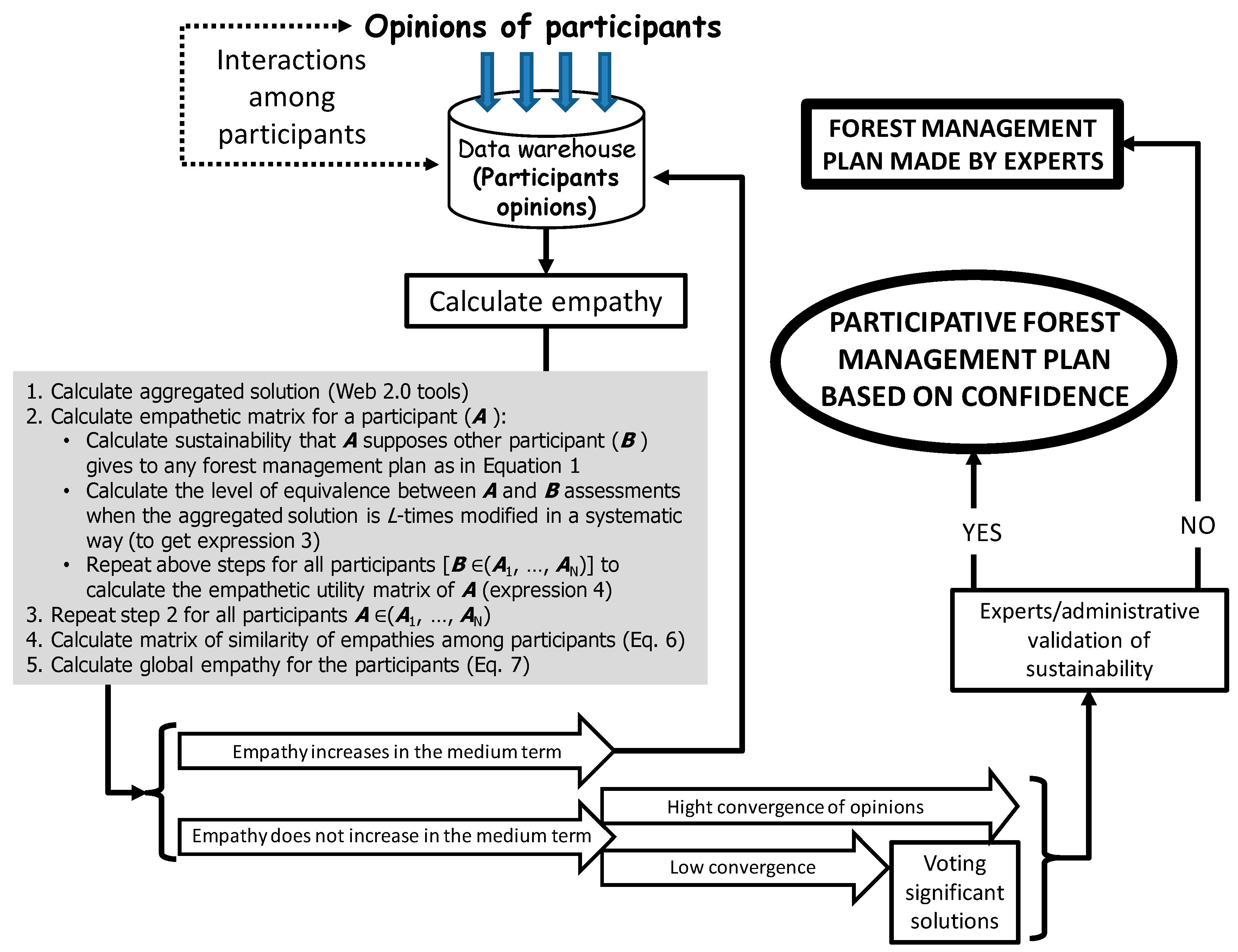
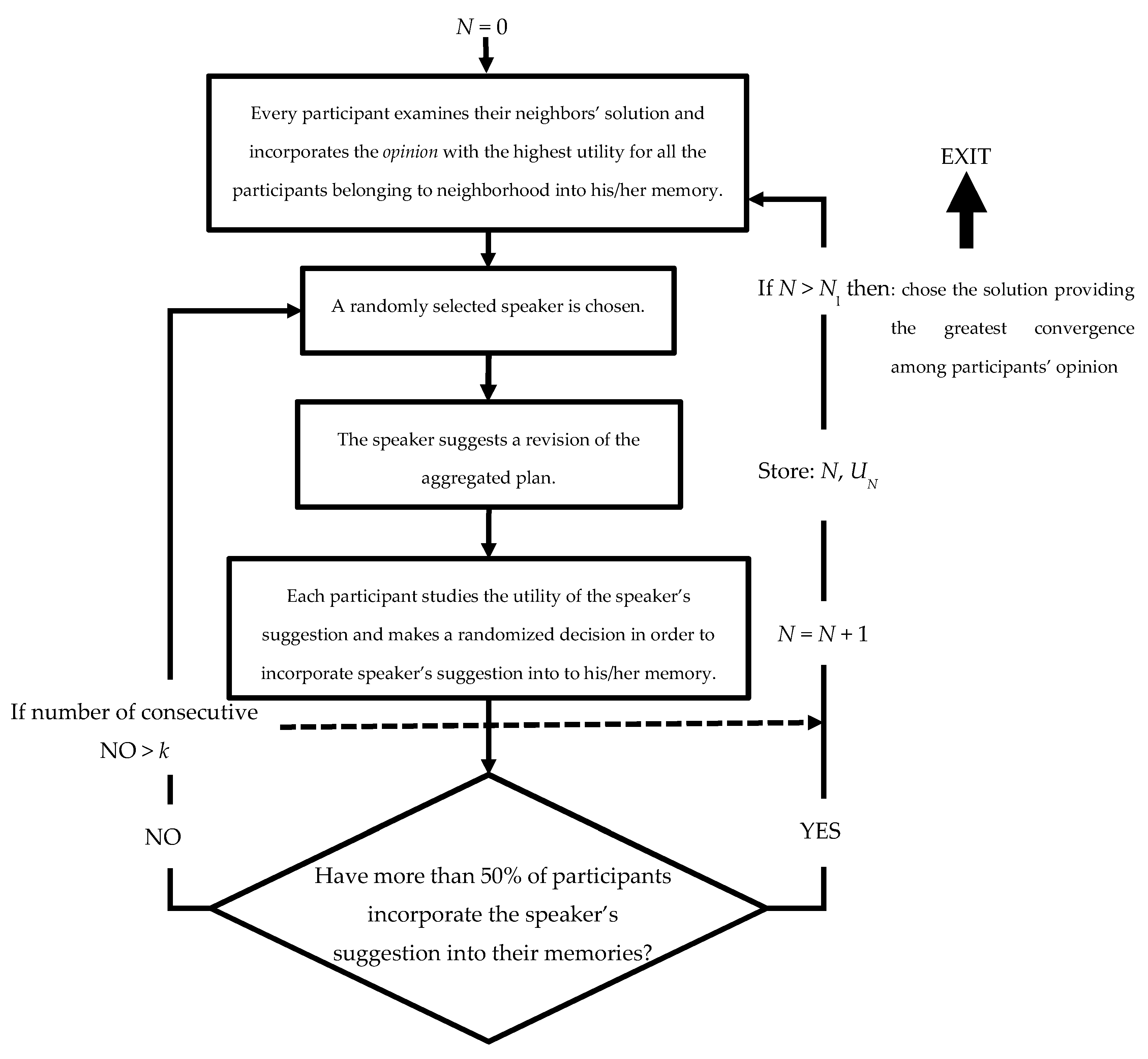
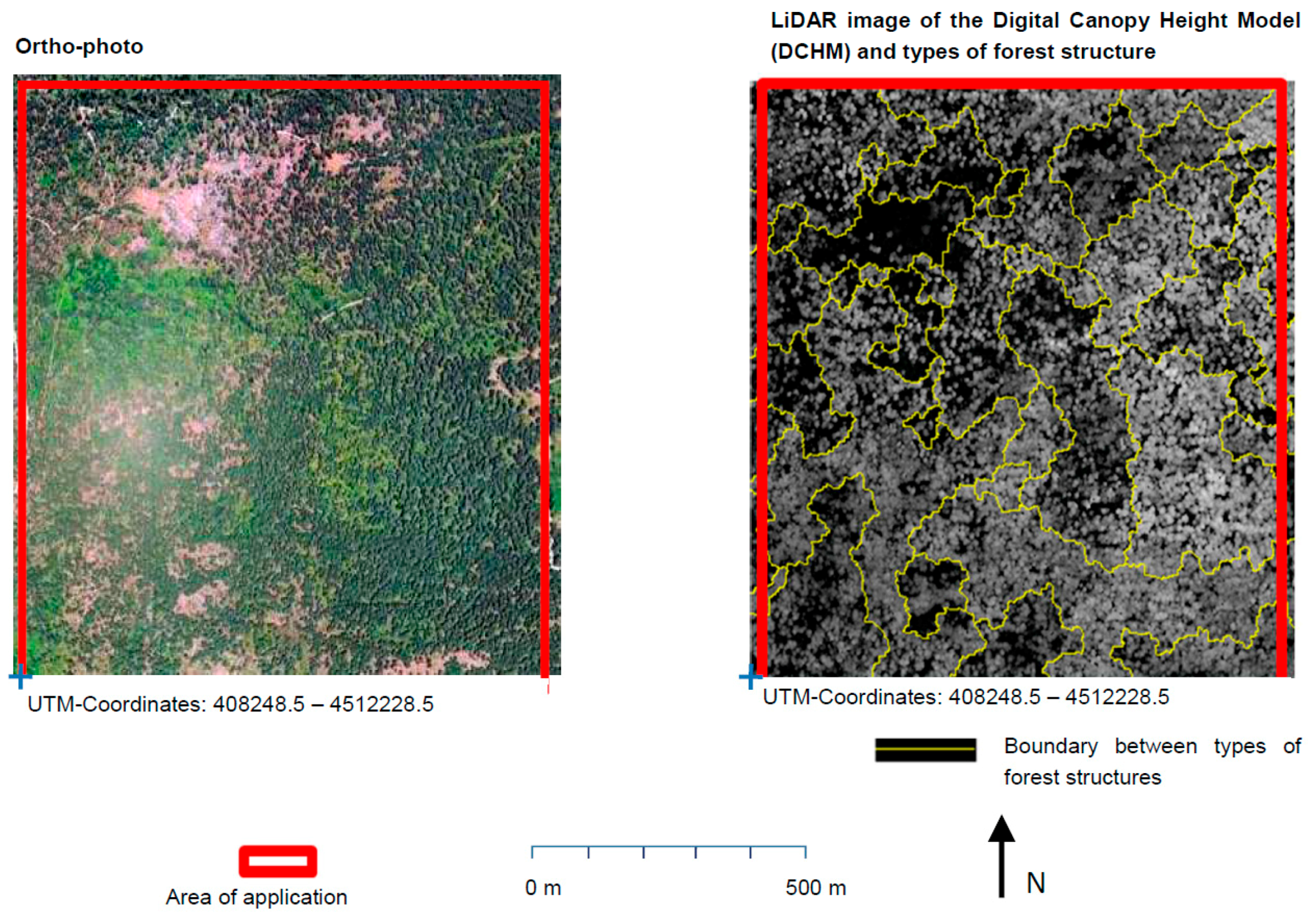
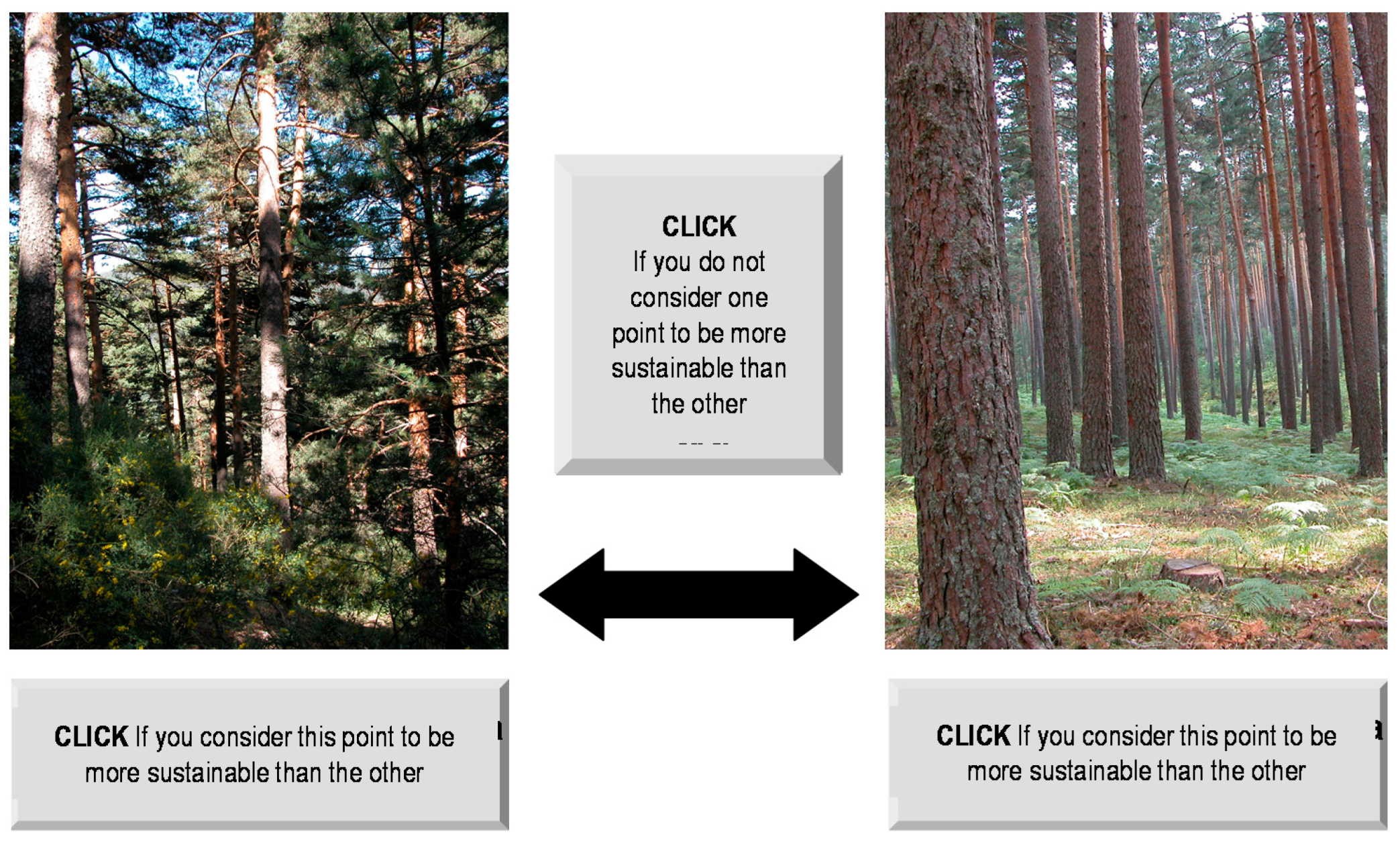
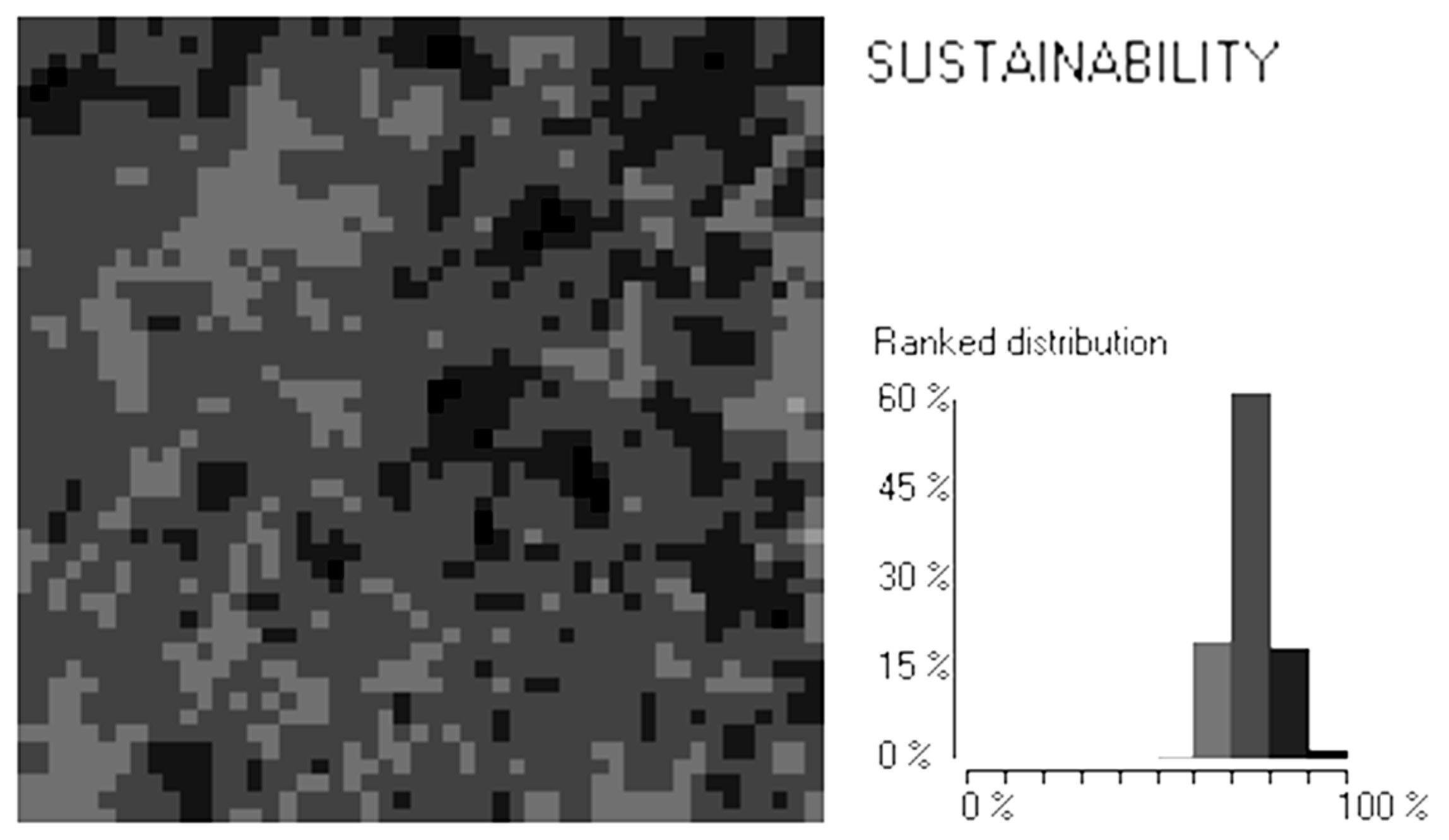
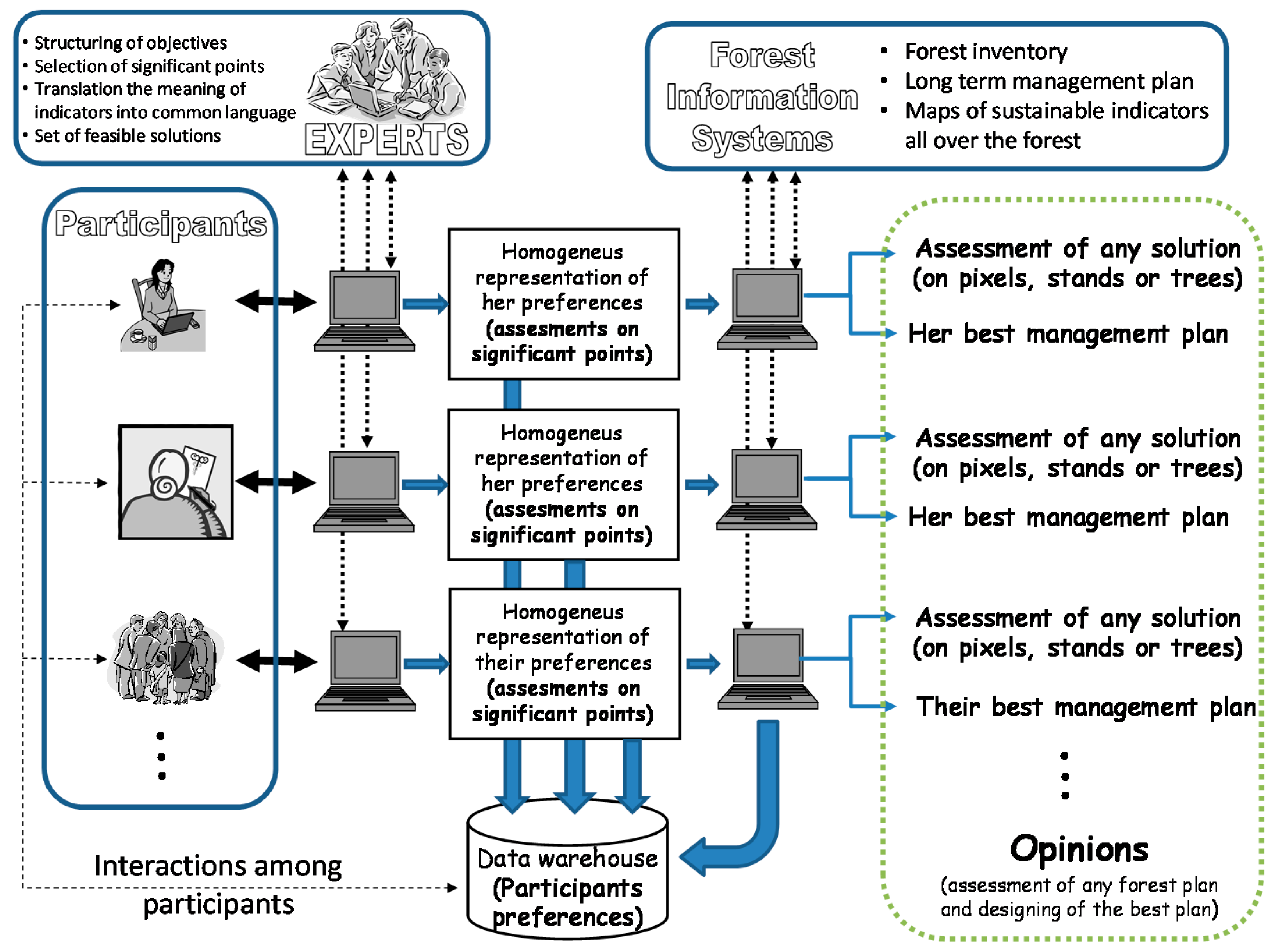

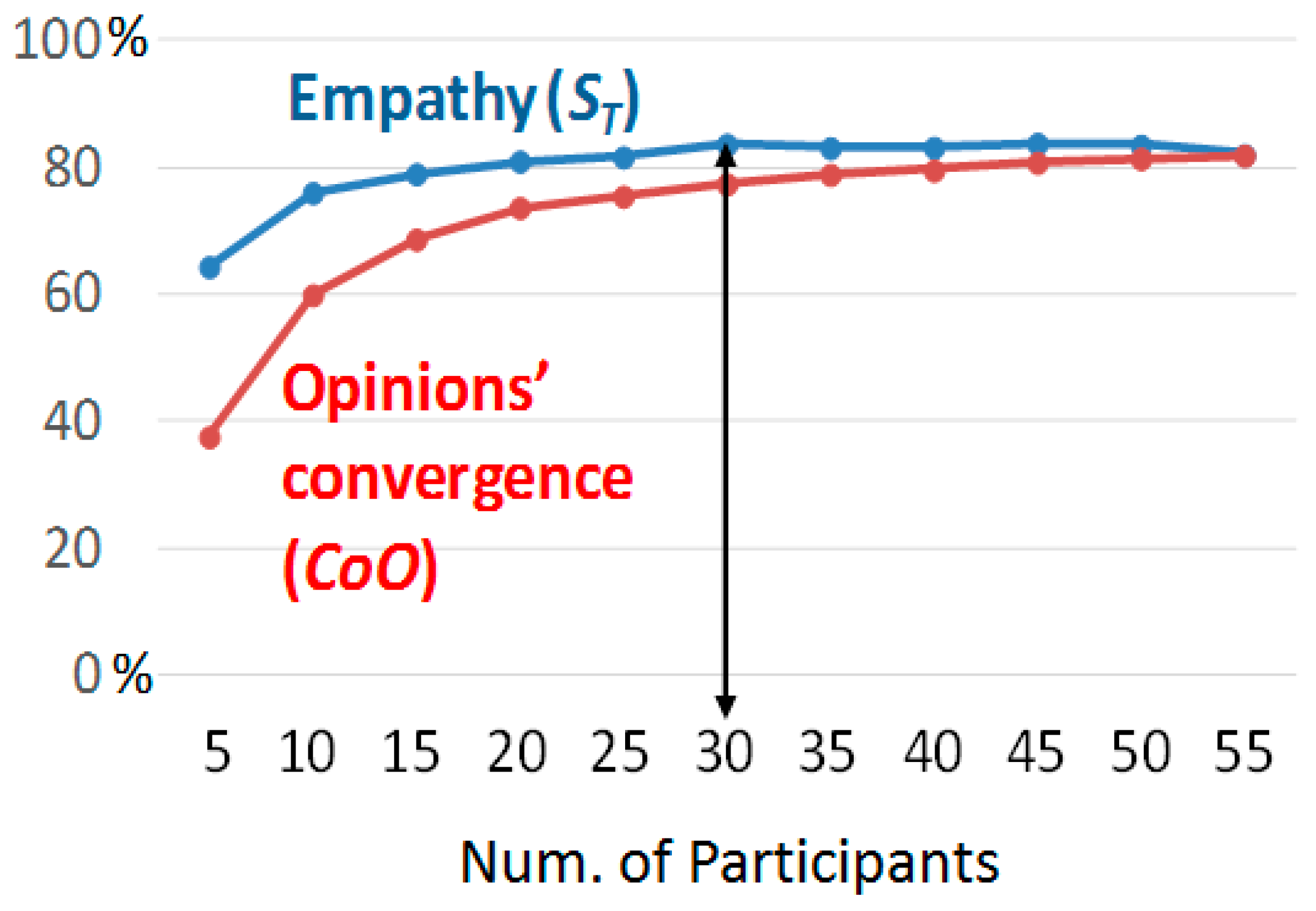
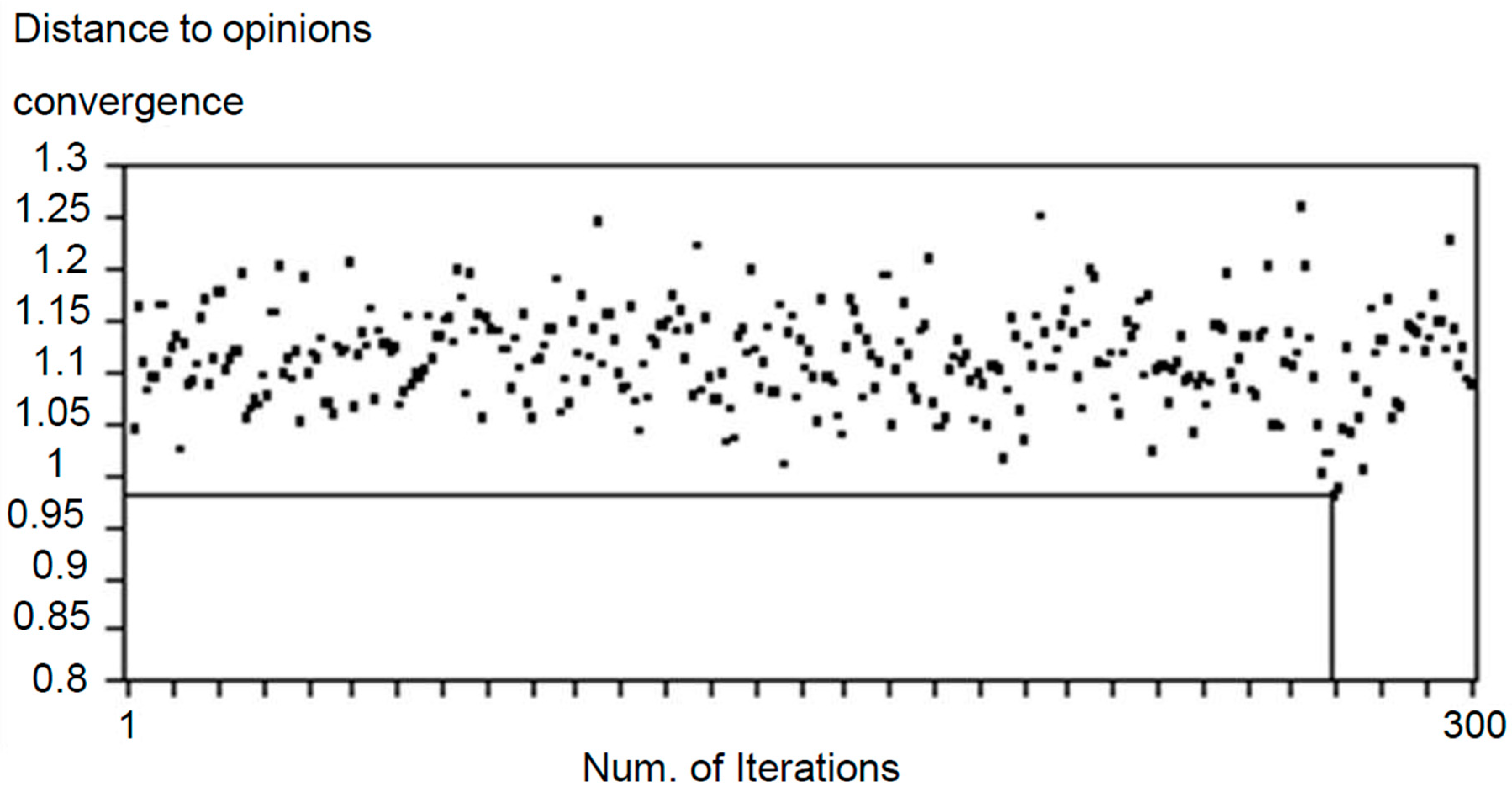
| Capabilities of the Available Application of Public Participation to Manage Collective Decision-Making | Type-A Systems | Type-B Systems | Type-C Systems | Confidence-Based Strategy | |
|---|---|---|---|---|---|
| See Section 1.3 | |||||
| General requirements | To be transparent and allow rebuttal by third parties in all its decisions | Yes | Partially | Yes | Yes |
| Adaptive to the available information and to the knowledge that the evaluator has in the participation process. | Partially | Partially | Partially | Yes | |
| Friendly (use is not affected by the technological, cultural or generational gap). | No | Yes | Partially | Yes | |
| Optimizer of individual utility and socially intelligent. | No | No | Yes | Yes | |
| To serve as an instrument for accountability to society. | Yes | Yes | Yes | Yes | |
| Outcome requirements | To provide assessments based on the representation of personal preferences. | Yes | No | Yes | Yes |
| Collective decision-making through aggregation of individual preferences | Yes | Yes | Yes | Yes | |
| Design of the alternative that best fits to any system of preferences (individual or aggregated). | Yes | No | No | Yes | |
| Capacity to solve large combinatorial problems | Not available in current applications | Yes | |||
| Comparison Points | Individual Preferences (Data Entered by a Participant) 1 | Preferences after Sequel and Transitive Closure [59] 2 | Sustainability at Compared Points | |||||||||||||
|---|---|---|---|---|---|---|---|---|---|---|---|---|---|---|---|---|
| ID | UTM X-coord. | UTM Y-coord. | 1 | 2 | 3 | 4 | 5 | 6 | 1 | 2 | 3 | 4 | 5 | 6 | Original value | [0,1] Rank |
| 1 | 408916,5 | 4512672,5 | 3 | 3 | 3 | 3 | 1 | 2 | 0 | 1 | 1 | 0 | 1 | 1 | 4.3 | 0.86 |
| 2 | 408776,5 | 4513172,5 | 3 | 3 | 1 | 3 | 3 | 3 | 1 | 0 | 1 | 1 | 1 | 1 | 5 | 1 |
| 3 | 408916,5 | 4512272,5 | 3 | 2 | 3 | 2 | 2 | 1 | 0 | 1 | 0 | 0 | 1 | 1 | 3 | 0.6 |
| 4 | 408976,5 | 4512852,5 | 3 | 3 | 1 | 3 | 1 | 2 | 1 | 1 | 1 | 0 | 1 | 0 | 4.1 | 0.82 |
| 5 | 408936,5 | 4512252,5 | 2 | 3 | 1 | 2 | 3 | 1 | 1 | 1 | 1 | 0 | 0 | 1 | 3.9 | 0.78 |
| 6 | 408516,5 | 4513012,5 | 1 | 3 | 2 | 1 | 2 | 3 | 1 | 1 | 1 | 1 | 0 | 0 | 3.7 | 0.74 |
| Stock Variables for Height Distribution | |||
|---|---|---|---|
| Tree Height (meters) | Timber to Harvest in 10 Years (stems/ha) | Trees after the Management Plan (stems/ha) | Standing Trees (stems/ha) |
| 0–3 | 30,879 | 632,880 | 230,142 |
| 3–6 | 3600 | 46,407 | 24,599 |
| 6–9 | 2458 | 13106 | 14,741 |
| 9–12 | 630 | 7176 | 7508 |
| 12–15 | 210 | 6155 | 6774 |
| 15–18 | 165 | 5032 | 4869 |
| 18–21 | 64 | 3515 | 3171 |
| 21–24 | 264 | 1459 | 1493 |
| Economic Variables after the Plan (in Euros for the Entire Area of 96.04 ha) | |||
| Cut & Harvest wood COST | 39,549.01 | ||
| Pruning & Debris elimination COST | 54,088.35 | ||
| Gross Timber INCOME | 54,399.77 | ||
| Bio-fuel & Public subsidies INCOME | 41,130.92 | ||
| Sustainability (as % of the IDEAL FOREST sustainability) | |||
| Current overall sustainability value | 74.99 | ||
| Overall sustainability after Plan | 86.51 | ||
| Participant-ID | Sustainability on the Comparison Points and for All the Territory | ||||||
|---|---|---|---|---|---|---|---|
| P-1 | P-2 | P-3 | P-4 | P-5 | P-6 | Study Area v(X) | |
| E-1 | 0.49 | 0.41 | 0.12 | 0.07 | 0.12 | 0.42 | 0.272 |
| E-2 | 0.89 | 0.16 | 0.37 | 0.27 | 0.07 | 0.42 | 0.363 |
| E-3 | 0.37 | 0.07 | 0.52 | 0.57 | 0.52 | 0.32 | 0.395 |
| E-4 | 0.42 | 0.34 | 0.87 | 0.46 | 0.42 | 0 | 0.418 |
| E-5 | 1 | 0 | 0.22 | 0.5 | 0.22 | 0.59 | 0.422 |
| E-6 | 0.59 | 0.46 | 0.97 | 0.27 | 0.07 | 0.27 | 0.438 |
| E-7 | 0 | 1 | 0.62 | 0.51 | 0.07 | 0.02 | 0.37 |
| E-8 | 0.85 | 0.42 | 0.82 | 0.62 | 0 | 0 | 0.452 |
| E-9 | 1 | 0.62 | 0.22 | 0 | 0 | 0.59 | 0.405 |
| E-10 | 0.75 | 0.07 | 0.52 | 0.47 | 0.02 | 0.87 | 0.45 |
| E-11 | 0.83 | 0.62 | 0.12 | 0.55 | 0 | 0.74 | 0.477 |
| E-12 | 0.45 | 0.62 | 1 | 0.47 | 0.32 | 0.22 | 0.513 |
| E-13 | 0.83 | 0.67 | 0.07 | 0.25 | 0 | 0.94 | 0.46 |
| E-14 | 0.32 | 0.22 | 0.72 | 0.67 | 0.92 | 0.22 | 0.512 |
| E-15 | 0.92 | 0.07 | 0.72 | 0.52 | 0.77 | 0.07 | 0.512 |
| E-16 | 0.57 | 0.07 | 0.67 | 0.52 | 0.97 | 0.02 | 0.47 |
| E-17 | 0.54 | 0.66 | 0.97 | 0.92 | 0 | 0.42 | 0.585 |
| E-18 | 1 | 0.72 | 0.32 | 0.7 | 0.32 | 0.64 | 0.617 |
| E-19 | 0.42 | 0.07 | 1 | 0.72 | 0.77 | 0.22 | 0.533 |
| E-20 | 1 | 0.87 | 0.07 | 0.8 | 0.27 | 0.64 | 0.608 |
| Group (g) | 0.414 | 0.254 | 0.341 | 0.308 | 0.183 | 0.238 | 0.29 |
| Expert (Ob) | 0.92 | 0.75 | 0.54 | 0.42 | 0.26 | 0.07 | 0.493 |
| Group | E-1 | E-2 | E-3 | E-4 | E-5 | E-6 | E-7 | E-8 | E-9 | E-10 | E-11 | E-12 | E-13 | E-14 | E-15 | E-16 | E-17 | E-18 | E-19 | E-20 |
|---|---|---|---|---|---|---|---|---|---|---|---|---|---|---|---|---|---|---|---|---|
| E-1 | 100 | 83.27 | 75.83 | 72.95 | 73.79 | 72.35 | 73.79 | 72.37 | 75.57 | 71.71 | 63.08 | 60.82 | 52.67 | 63.2 | 63.44 | 59.35 | 56.78 | 49.97 | 55.62 | 64.3 |
| E-2 | 83.27 | 100 | 88.93 | 85.39 | 88.9 | 87.2 | 63.2 | 87.29 | 71.87 | 85.57 | 62.58 | 75.83 | 46.9 | 65.55 | 74.38 | 54.14 | 72.15 | 66.05 | 60.56 | 74.46 |
| E-3 | 75.83 | 88.93 | 100 | 93.58 | 88.11 | 89.97 | 54.91 | 89.58 | 61.35 | 83.5 | 52.73 | 82.4 | 36.57 | 72.14 | 83.11 | 57.42 | 75.87 | 69.08 | 67.63 | 68.11 |
| E-4 | 72.95 | 85.39 | 93.58 | 100 | 86.34 | 91.29 | 54.39 | 91.33 | 59.71 | 82.7 | 51.6 | 85.32 | 35.23 | 74.45 | 86.95 | 57.82 | 78.19 | 69.42 | 71.28 | 67.35 |
| E-5 | 73.79 | 88.9 | 88.11 | 86.34 | 100 | 90.7 | 56.55 | 90.32 | 66.37 | 93.83 | 59.56 | 82.21 | 42.41 | 64.09 | 79.04 | 50.24 | 79.57 | 73.19 | 62.53 | 76.04 |
| E-6 | 72.35 | 87.2 | 89.97 | 91.29 | 90.7 | 100 | 56.2 | 97.55 | 63.9 | 88.9 | 57.17 | 87.9 | 39.84 | 66.98 | 81.22 | 50.86 | 83.54 | 74.08 | 65.37 | 74.18 |
| E-7 | 73.79 | 63.2 | 54.91 | 54.39 | 56.55 | 56.2 | 100 | 56.36 | 79.17 | 57.44 | 71.43 | 45.57 | 68.62 | 45.21 | 45.47 | 43.33 | 44.42 | 36.26 | 40.15 | 58.97 |
| E-8 | 72.37 | 87.29 | 89.58 | 91.33 | 90.32 | 97.55 | 56.36 | 100 | 64.15 | 88.18 | 57.34 | 87.39 | 40.03 | 67.02 | 81.32 | 50.98 | 83.2 | 73.92 | 65.28 | 74.41 |
| E-9 | 75.57 | 71.87 | 61.35 | 59.71 | 66.37 | 63.9 | 79.17 | 64.15 | 100 | 67.75 | 86.42 | 53.09 | 74.46 | 44.22 | 49.74 | 38.29 | 53.62 | 48.19 | 39.89 | 73.91 |
| E-10 | 71.71 | 85.57 | 83.5 | 82.7 | 93.83 | 88.9 | 57.44 | 88.18 | 67.75 | 100 | 62.35 | 81.21 | 44.86 | 61.06 | 75.94 | 47.06 | 80.96 | 73.11 | 60.73 | 78.33 |
| E-11 | 63.08 | 62.58 | 52.73 | 51.6 | 59.56 | 57.17 | 71.43 | 57.34 | 86.42 | 62.35 | 100 | 48.09 | 80.3 | 34.16 | 41.94 | 26.53 | 50.91 | 46.59 | 31.29 | 74.54 |
| E-12 | 60.82 | 75.83 | 82.4 | 85.32 | 82.21 | 87.9 | 45.57 | 87.39 | 53.09 | 81.21 | 48.09 | 100 | 29.86 | 63.65 | 81.8 | 44.88 | 90.67 | 80.79 | 64.54 | 68.82 |
| E-13 | 52.67 | 46.9 | 36.57 | 35.23 | 42.41 | 39.84 | 68.62 | 40.03 | 74.46 | 44.86 | 80.3 | 29.86 | 100 | 21.63 | 25.83 | 18.1 | 32.06 | 27.26 | 17.98 | 55.26 |
| E-14 | 63.2 | 65.55 | 72.14 | 74.45 | 64.09 | 66.98 | 45.21 | 67.02 | 44.22 | 61.06 | 34.16 | 63.65 | 21.63 | 100 | 77.97 | 78.02 | 56.08 | 46.39 | 86.73 | 44.2 |
| E-15 | 63.44 | 74.38 | 83.11 | 86.95 | 79.04 | 81.22 | 45.47 | 81.32 | 49.74 | 75.94 | 41.94 | 81.8 | 25.83 | 77.97 | 100 | 60.02 | 74.4 | 65.74 | 79.18 | 58.31 |
| E-16 | 59.35 | 54.14 | 57.42 | 57.82 | 50.24 | 50.86 | 43.33 | 50.98 | 38.29 | 47.06 | 26.53 | 44.88 | 18.1 | 78.02 | 60.02 | 100 | 37.49 | 28.38 | 69.75 | 31.03 |
| E-17 | 56.78 | 72.15 | 75.87 | 78.19 | 79.57 | 83.54 | 44.42 | 83.2 | 53.62 | 80.96 | 50.91 | 90.67 | 32.06 | 56.08 | 74.4 | 37.49 | 100 | 85.05 | 57.97 | 72.77 |
| E-18 | 49.97 | 66.05 | 69.08 | 69.42 | 73.19 | 74.08 | 36.26 | 73.92 | 48.19 | 73.11 | 46.59 | 80.79 | 27.26 | 46.39 | 65.74 | 28.38 | 85.05 | 100 | 47.02 | 71.44 |
| E-19 | 55.62 | 60.56 | 67.63 | 71.28 | 62.53 | 65.37 | 40.15 | 65.28 | 39.89 | 60.73 | 31.29 | 64.54 | 17.98 | 86.73 | 79.18 | 69.75 | 57.97 | 47.02 | 100 | 42.45 |
| E-20 | 64.3 | 74.46 | 68.11 | 67.35 | 76.04 | 74.18 | 58.97 | 74.41 | 73.91 | 78.33 | 74.54 | 68.82 | 55.26 | 44.2 | 58.31 | 31.03 | 72.77 | 71.44 | 42.45 | 100 |
| Type of Stakeholder | Parameters: (μ; σ) | Number of Simulations | |||||
|---|---|---|---|---|---|---|---|
| P1 | P2 | P3 | P4 | P5 | P6 | ||
| S1 | (0.88; 0.2) | (0.6; 0.3) | (0.75; 0.4) | (0.55; 0.2) | (0.2; 0.3) | 0.25; 0.4) | 18 |
| S2 | (0.4; 0.4) | (0.92; 0.4) | (0.75; 0.4) | (0.54; 0.2) | (0.1; 0.2) | (0.2; 0.2) | 13 |
| S3 | (0.5; 0.2) | (0.2; 0.2) | (0.75; 0.2) | (0.6; 0.2) | (0.7; 0.2) | (0.3; 0.2) | 14 |
| S4 | (0.96; 0.2) | (0.5; 0.3) | (0.25; 0.2) | (0.33; 0.3) | (0.1; 0.2) | (0.72; 0.2) | 23 |
| S5 | (0.77; 0.3) | (0.69; 0.4) | (0.75; 0.3) | (0.5; 0.4) | (0.2; 0.3) | (0.4; 0.4) | 32 |
© 2018 by the authors. Licensee MDPI, Basel, Switzerland. This article is an open access article distributed under the terms and conditions of the Creative Commons Attribution (CC BY) license (http://creativecommons.org/licenses/by/4.0/).
Share and Cite
Martínez-Falero, E.; González-García, C.; García-Abril, A.; Ayuga-Téllez, E. Validation of a Methodology for Confidence-Based Participatory Forest Management. Forests 2018, 9, 399. https://doi.org/10.3390/f9070399
Martínez-Falero E, González-García C, García-Abril A, Ayuga-Téllez E. Validation of a Methodology for Confidence-Based Participatory Forest Management. Forests. 2018; 9(7):399. https://doi.org/10.3390/f9070399
Chicago/Turabian StyleMartínez-Falero, Eugenio, Concepción González-García, Antonio García-Abril, and Esperanza Ayuga-Téllez. 2018. "Validation of a Methodology for Confidence-Based Participatory Forest Management" Forests 9, no. 7: 399. https://doi.org/10.3390/f9070399
APA StyleMartínez-Falero, E., González-García, C., García-Abril, A., & Ayuga-Téllez, E. (2018). Validation of a Methodology for Confidence-Based Participatory Forest Management. Forests, 9(7), 399. https://doi.org/10.3390/f9070399





